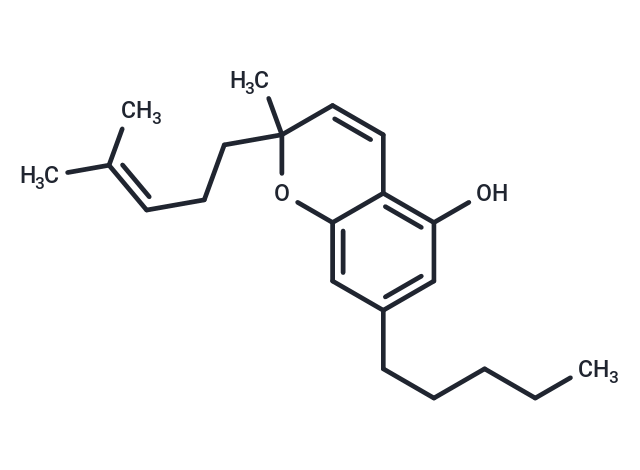Shopping Cart
- Remove All
 Your shopping cart is currently empty
Your shopping cart is currently empty

(±)-Cannabichromene is a major non-psychotropic phytocannabinoid that inhibits endocannabinoid inactivation and activates the transient receptor potential ankyrin-1 (TRPA1), it selectively reduces inflammation-induced hypermotility in vivo in a manner that is not dependent on cannabinoid receptors or TRPA1.

| Pack Size | Price | Availability | Quantity |
|---|---|---|---|
| 1 mg | $173 | In Stock | |
| 5 mg | $432 | In Stock | |
| 10 mg | $628 | In Stock | |
| 25 mg | $986 | In Stock | |
| 50 mg | $1,320 | In Stock | |
| 100 mg | $1,790 | In Stock | |
| 500 mg | $3,590 | In Stock | |
| 1 mL x 10 mM (in DMSO) | $550 | In Stock |
| Description | (±)-Cannabichromene is a major non-psychotropic phytocannabinoid that inhibits endocannabinoid inactivation and activates the transient receptor potential ankyrin-1 (TRPA1), it selectively reduces inflammation-induced hypermotility in vivo in a manner that is not dependent on cannabinoid receptors or TRPA1. |
| In vitro | Cannabichromene (CBC)? activated CB2 but not CB1 receptors to produce hyperpolarization of AtT20 cells.?This activation was inhibited by a CB2 receptor antagonist AM630, and sensitive to Pertussis toxin.?Application of CBC reduced activation of CB2 , but not CB1 , receptors by subsequent co-application of CP55,940, an efficacious CB1 and CB2 receptor agonist.?Continuous CBC application induced loss of cell surface CB2 receptors and desensitization of the CB2 receptor-induced hyperpolarization[2]. |
| Alias | Cannabichromene |
| Molecular Weight | 314.46 |
| Formula | C21H30O2 |
| Cas No. | 20675-51-8 |
| Smiles | OC1=C2C(OC(CCC=C(C)C)(C)C=C2)=CC(CCCCC)=C1 |
| Relative Density. | 1.0536 g/cm3 (Estimated) |
| Storage | Powder: -20°C for 3 years | In solvent: -80°C for 1 year | Shipping with blue ice. | |||||||||||||||||||||||||||||||||||
| Solubility Information | DMSO: 55 mg/mL (174.9 mM), Sonication is recommended. | |||||||||||||||||||||||||||||||||||
Solution Preparation Table | ||||||||||||||||||||||||||||||||||||
DMSO
| ||||||||||||||||||||||||||||||||||||

Copyright © 2015-2025 TargetMol Chemicals Inc. All Rights Reserved.